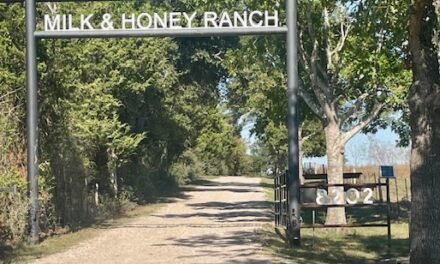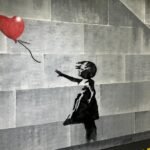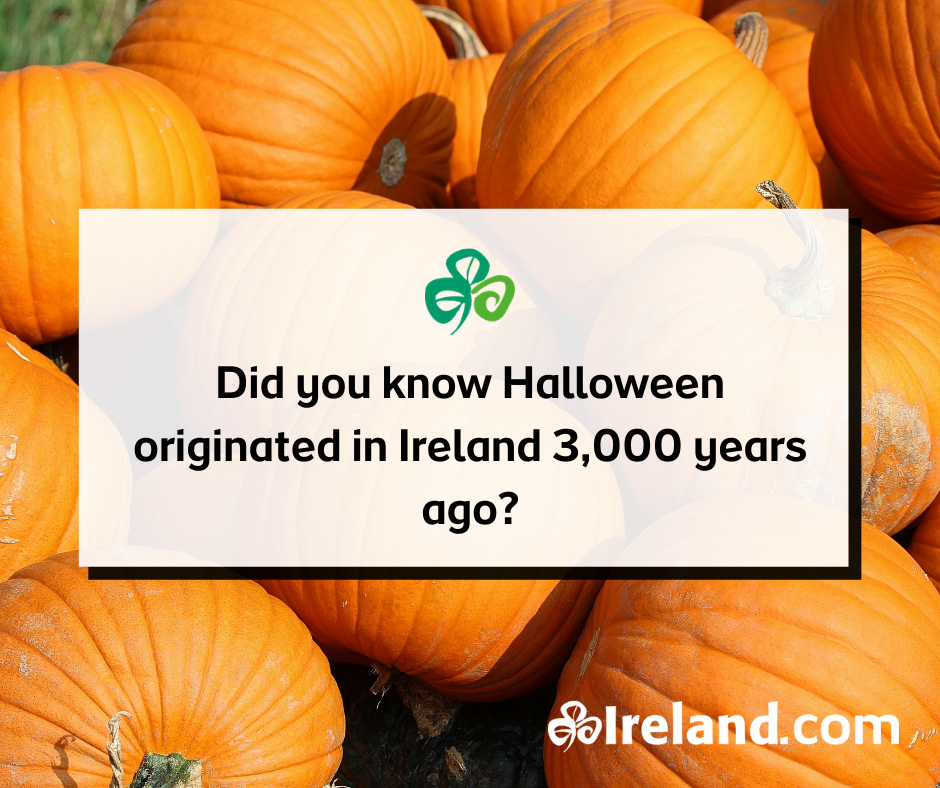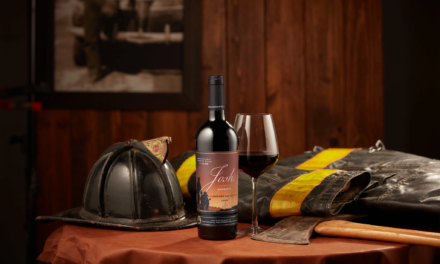
Ireland Home of Halloween: History, Fun Facts and a Ghost Story

We celebrate Halloween every year, but have you ever given thought to where the celebrations and traditions originated? Our friends over in Ireland have been kind enough to share with us the history of Halloween’s origin, some fun facts and a ghost story.
Halloween Origin…
Halloween originates in the ancient Irish and Celtic tradition of Samhain which is the old Irish for ‘summer’s end’. Samhain marks the end of the old Celtic Year and the beginning of the New Year. The Celts believed that this was a time of transition, when the veil between our world and the next came down, and the spirits of all who had died since the last Oíche Shamhna (Night of Samhain) moved on to the next life.
Samhain was the last great gathering before winter when clans came from all over
Ireland to celebrate, trade and connect. It was a time for fires, feasting, remembering what had passed, a time of reckoning, rebirth and preparing for the New Year ahead.
Samhain Festival:
- Samhain marks the turning point in the calendar which marks the end of the season of light – harvest – and the beginning of the dark half of the year. This moment of transition is believed to allow a brief interaction between the otherworld and this world.
- First day of winter, traditionally kept on 1st November to align with the Feast of All Saints day in the Christian calendar.
- The vigil of the feast is Halloween, the night when charms and incantations are at their most powerful, when people looked into the future and when feasting and merriment were ordained.
- Traditionally this was a day of abstinence when no flesh meat was to be consumed.
One of the main spiritual centres of the ancient Celts was located on top of the Hill of Tlachtga, now called the Hill of Ward, near Athboy, Co. Meath. The druids felt that this world and the otherworld were closest at Tlachtga and it was here, according to legend and archaeological evidence, that the festival of Samhain, or Halloween, was started. The old year’s fires were extinguished, and, after sunset, the ceremonial New Year Samhain fire was lit here. Torches were lit from this sacred fire and carried to seven other hills around the county including Tara and Loughcrew, and then on to light up the whole countryside.
Excerpts published by leading archaeology website Ancient Origins state:
“In an era long passed, all of the fires of Ireland were extinguished at sundown on October 31st and a single blazing bonfire was lit at the epicentre of the annual feast of the dead -Samhain had begun at the Hill of Ward (Tlachtga – near Athboy). The Druidical priests gathered the people together and set places with food offerings for those unseen who had crossed into the land of the dead. For between the nights of October 31st and November 1st, the barriers between the worlds – which closed the doors of perception throughout the year – would fall away and the dimensions would interact freely with one another. At this time, when the harvest faded and the darker time of winter began, the known and the unknown would meet and dance in the flickering light of the celebratory flames…”
Recent archaeological surveys led by Dr. Steve Davis of UCD School of Archaeology, have found evidence to support this claim with signs of ritualistic fire activity and gatherings stretching back to 1100BC, 500 years before the Celts.
Mythology
This time was also known as Féile na Marbh (the Feast of the Dead). As the veil between worlds thinned, all manner of spirits walked abroad at Samhain, including those of loved ones passed on.
Among those coming forth from the chasm of space and time between summer and winter are the harbingers of Light (Boann), Dark (the Morrigan), Mischief (Fear Dearg), and Change (Púca).
The tradition of wearing of costumes and masks at Samhain developed to deceive these same unfriendly spirits lest they recognised you and called you to the Otherworld before your time. Nervous living folk would attempt to appease the wandering spirit with gifts of fruit and nuts, which may be the origin of the ubiquitous treat or treating.
Among the many spectres that haunt the land at Halloween are those who represent the four aspects of Samhain – light, dark, mischief and change.
The heroic figure of Fionn Mac Cumhaill (Finn McCool) and the gentle spirit of the goddess Boann represent the light.
Boann tended a well within which lived the Salmon of Knowledge. When the well flooded it washed Boann away and she became the River Boyne. She cradled the Salmon of Knowledge until it was time to give it to a hero called Fionn Mac Cumhaill.
Fionn ate the Salmon of Knowledge and gained all the wisdom of the world. He was then called upon to kill the evil goblin Aillen, who appeared every Samhain to burn down the great halls of Tara, the seat of the High King. Fionn succeeded and as a reward he was made leader of the High King’s elite warriors.
At Halloween look out for the shadows of Fionn’s two loyal hounds that herald the arrival of his spirit, or a gently glowing figure with the head of a white cow and a body made of reeds that is the presence of the goddess Boann.
The dark aspect of Samhain is Morrigan, goddess of war. She takes the form of a raven and leads an army of misshapen creatures on the hunt for human lives. If you hear flapping nearby, beware!
Mischief and mayhem are let loose by the ill-mannered Fear Dearg, the Red Men. Sharp toothed, squat and dressed in red coat and cap they love to play practical jokes on humans, the more gruesome the better.
The spirits of change are the púca, shape-shifters who can change the fortunes of anyone they meet. Whatever their shape, whether cat or stranger, you can recognise them by their black hair and golden eyes.
One of the best ways to protect yourself from marauding spirits is through disguise and this is a part of Samhain that lives on in the custom of dressing up at Halloween. To appease the spirits, people also went from house to house in costume to sing songs or recite verses in exchange for food for the souls of the dead.
This tradition is embodied in the performances of the Armagh Rhymers, one of the most celebrated traditional music and theatre ensembles on the island of Ireland. The Rhymers are masked with wicker disguises and perform music, storytelling and drama.
Ghost Story: The Lady in White of Charles Fort
Shortly after the construction of Charles Fort, Colonel Warender, a strict disciplinarian, was appointed Governor. He had a daughter Wilful who became engaged to Sir Trevor Ashurst and she subsequently married him. On the evening of their wedding day, the bride, while walking with the bridegroom on the battlements, saw some flowers growing on the rocks below. She expressed a wish to have them and a sentry posted nearby volunteered to climb down to get the flowers, providing that Sir Trevor took his place during his absence. The latter agreed and took the soldiers coat and a musket while the sentry went in search of a rope.
The task took longer than expected and after some time Sir Trevor fell asleep. Meanwhile the Governor doing his rounds of the sentries came to the post where Sir Trevor was asleep. Receiving no answer to his challenge, he drew his pistol and shot the sentry dead. The body was carried down to the parade ground and it was only then that the Governor realised what had happened. The bride appears to have gone indoors before the tragedy occurred, but when she learned of the fate of her husband, she rushed from the house in distraction and flung herself over the battlements. Since that time she is reported to have made many appearances on the battlements and because she is wearing her wedding dress she has become known as the ‘The Lady in White’.
For more information on Ireland as a vacation destination check out www.ireland.com.
Do you have a favorite Irish ghost story or Halloween tip you would like to share? Please comment below!
Happy Halloween!



















![Pape’ete’s First 5-Star Luxury Accommodations: Hilton Tahiti Resort [NOVEMBER 15]](https://luxebeatmag.com/wp-content/uploads/2021/09/Heiva-Lounge-Bar-1-440x264.jpg)























